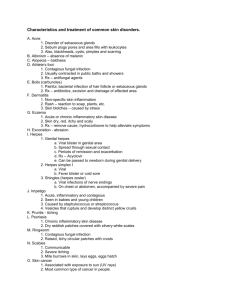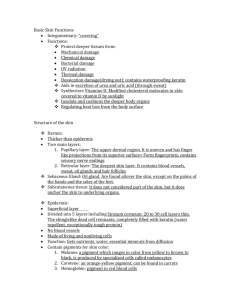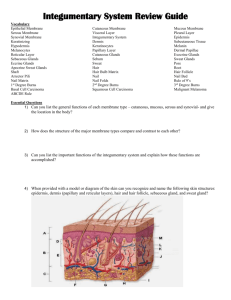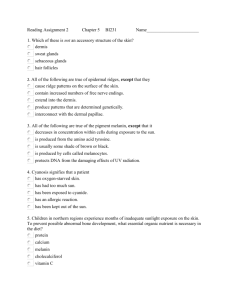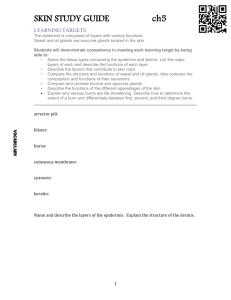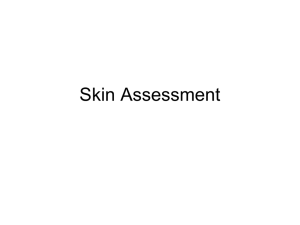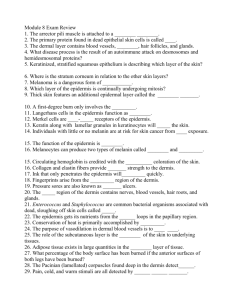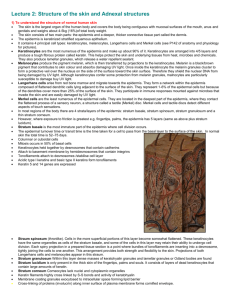Integumentary System Notes
advertisement
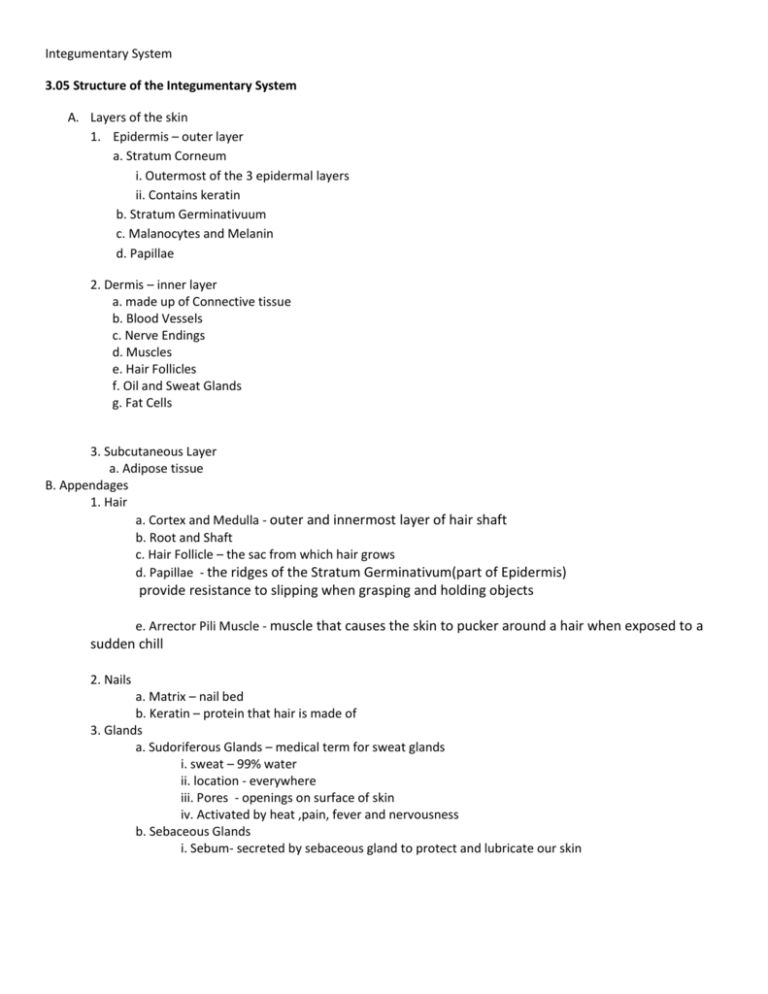
Integumentary System 3.05 Structure of the Integumentary System A. Layers of the skin 1. Epidermis – outer layer a. Stratum Corneum i. Outermost of the 3 epidermal layers ii. Contains keratin b. Stratum Germinativuum c. Malanocytes and Melanin d. Papillae 2. Dermis – inner layer a. made up of Connective tissue b. Blood Vessels c. Nerve Endings d. Muscles e. Hair Follicles f. Oil and Sweat Glands g. Fat Cells 3. Subcutaneous Layer a. Adipose tissue B. Appendages 1. Hair a. Cortex and Medulla - outer and innermost layer of hair shaft b. Root and Shaft c. Hair Follicle – the sac from which hair grows d. Papillae - the ridges of the Stratum Germinativum(part of Epidermis) provide resistance to slipping when grasping and holding objects e. Arrector Pili Muscle - muscle that causes the skin to pucker around a hair when exposed to a sudden chill 2. Nails a. Matrix – nail bed b. Keratin – protein that hair is made of 3. Glands a. Sudoriferous Glands – medical term for sweat glands i. sweat – 99% water ii. location - everywhere iii. Pores - openings on surface of skin iv. Activated by heat ,pain, fever and nervousness b. Sebaceous Glands i. Sebum- secreted by sebaceous gland to protect and lubricate our skin 3.06 Functions of the Integumentary System & Characteristics and Treatments of Common Skin Disorders A. Skin 1. Protection a. intact skin is the best protector b. skin is generaly too dry for bacterial growth c. most skin bacteria is associated with sweat glands and hair follicles d. Hand-washing is the best way to prevent the spread od disease. 2. Regulate body temp 3. Manufactures Vitamin D 4. Sensory Perception – feel/ touch 5. Storage - water, fat, products of metabolism 6. Sun Screen – protects the skin from UV rays 7. Absorption – topical meds B. Glands 1. Sudoriferous Glands/ Sweat Glands a. Perspiration is 99% Water b. Distributed over the entire surface of the body with the greatest concentration in arm pits, palms of hand, soles of feet and forehead c. Perspiration excreted through the pores d. May be activated by heat, pain, fever, and nervousness e. Underarm odor caused by bacteria mixed with sweat f. Average fluid loss =500 cc daily 2. Sebaceous Glands a.Sebum – oil b. Protects and lubricates the skin Characteristics and Treatments of Common Skin Disorder A. Acne 1. Disorder of the Sebaceous Glands 2. Sebum plugs pores and area filled with leukocytes 3. Also develop black heads, cysts, pimples and scarring. B. Albinism – lack of melanin C. Alopecia – hair loss when normal hair is replaced by a very short, transparent hair D. Athlete’s Foot 1. Contagious fungal infection 2. Usually contracted in public baths and showers 3. Rx Antifungal medication E. Dermatitis 1. Non-specific skin inflammation 2. Rash – reaction to soap, plants 3. Skin blotches caused by stress F. Herpes – viral infection presents as a blister. Common types are Herpes simplex, genital herpes and herpes zoster(shingles). Simplex presents around the mouth and is known as cold sore or fever blister. Can spread through oral contact. 1. Genital Herpes a. Viral blister in genital area b. Spread through sexual contact c. Periods of remission and exacerbation d. Rx – Acyclovir e. Can be passed to newborn during genital delivery G. Skin cancer 1. Associated with exposure to sun (UV Rays) 2. Most common type of cancer in people 3. Melanoma a. Malignant b. Occurs in melanocytes c. Metastasizes o other areas quickly d. Brown or black irregular patch that occurs suddenly e. Change in existing wart or mole may indicate melanoma f. Rx – surgical removal of melanoma and surrounding area and chemotherapy 4. Basil Cell - the most common and least malignant form of cancer 5. Squamous Cell – arises from epidermis presenting mostly on the scalp and lower lip requiring surgical removal or radiation H. Burns 1. First degree a. Superficial burn, skin is red and dry b. Involves only the epidermis c. Rx. Cold Water d. Heals in one week 2. Second Degree a. Involves the epidermis and dermis b. Pain, swelling, redness and blistering c. Subject to infection d. Rx – pain medication, dry sterile dressing e. Healing w/in 2 wks 3. Third Degree a. Involves all 3 layers: epidermis, dermis, subcutaneous b. Loss of skin, blackened skin c. May be life threatening I. J. K. L. M. N. O. P. d. Rx - prevention of infection, fluid replacement, skin grafting 4. Rule of nines – method of measuring the percentage of the body that’s burned.Body is divided into 11 areas and each area is accounts for 9% of the total body surface. See text Eczema – acute or chronic non-contagious inflammatory skin disease with dry, red itchy, scaly areas. Impetigo - vesicles that rupture and develop yellow crust. Psoriasis – chronic inflammatory skin disease characterized by dry reddish patches covered with silverywhite scales Ringworm – highly contagious fungal infection with raised, itchy, circular crusty patches Scabies - skin rash with severe itching and mites Shingles(Herpes Zoster) Same virus causes chicken pox in children. skin eruption d/t viral infection of nerve endings. Warts - skin rash with severe itching and mites Skin Lesions 1. Macule – localized change in skin color < 1 cm in size. Eg. freckle 2. Papule – solid elevated lesion < 1 cm in diameter 3. Pustle – vesicles or bullae filled with pus usually < .5 cm in diameter. Eg. Acne, impetigo, 4. Ulcer – depressed lesion of the epidermis and upper layer of dermis eg. Decubitus 5. Vesicle - small blister containing serous fluid eg Herpes simplex, herpes zoster, chicken-pox

